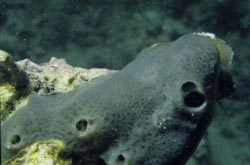Clues to nervous system evolution found in nerve-less sponge

The genes of Amphimedon queenslandica, a marine sponge native to the Great Barrier Reef, Australia, have been fully sequenced, allowing the researchers to monitor gene expression for signs of neural development. Credit: UCSB<br>
“If you're interested in finding the truly ancient origins of the nervous system itself, we know where to look,” said Kenneth Kosik, Harriman Professor of Neuroscience Research in the Department of Molecular, Cellular & Developmental Biology, and co-director of UCSB's Neuroscience Research Institute.
That place, said Kosik, is the evolutionary period of time when virtually the rest of the animal kingdom branched off from a common ancestor it shared with sponges, the oldest known animal group with living representatives. Something must have happened to spur the evolution of the nervous system, a characteristic shared by creatures as simple as jellyfish and hydra to complex humans, according to Kosik.
A previous sequencing of the genome of the Amphimedon queenslandica –– a sponge that lives in Australia's Great Barrier Reef –– showed that it contained the same genes that lead to the formation of synapses, the highly specialized characteristic component of the nervous system that sends chemical and electrical signals between cells. Synapses are like microprocessors, said Kosik explaining that they carry out many sophisticated functions: They send and receive signals, and they also change behaviors with interaction –– a property called “plasticity.”
“Specifically, we were hoping to understand why the marine sponge, despite having almost all the genes necessary to build a neuronal synapse, does not have any neurons at all,” said the paper's first author, UCSB postdoctoral researcher Cecilia Conaco, from the UCSB Department of Molecular, Cellular, and Developmental Biology (MCDB) and Neuroscience Research Institute (NRI). “In the bigger scheme of things, we were hoping to gain an understanding of the various factors that contribute to the evolution of these complex cellular machines.”
This time the scientists, including Danielle Bassett, from the Department of Physics and the Sage Center for the Study of the Mind, and Hongjun Zhou and Mary Luz Arcila, from NRI and MCDB, examined the sponge's RNA (ribonucleic acid), a macromolecule that controls gene expression. They followed the activity of the genes that encode for the proteins in a synapse throughout the different stages of the sponge's development.
“We found a lot of them turning on and off, as if they were doing something,” said Kosik. However, compared to the same genes in other animals, which are expressed in unison, suggesting a coordinated effort to make a synapse, the ones in sponges were not coordinated.
“It was as if the synapse gene network was not wired together yet,” said Kosik. The critical step in the evolution of the nervous system as we know it, he said, was not the invention of a gene that created the synapse, but the regulation of preexisting genes that were somehow coordinated to express simultaneously, a mechanism that took hold in the rest of the animal kingdom.
The work isn't over, said Kosik. Plans for future research include a deeper look at some of the steps that lead to the formation of the synapse; and a study of the changes in nervous systems after they began to evolve.
“Is the human brain just a lot more of the same stuff, or has it changed in a qualitative way?” he asked.
Media Contact
More Information:
http://www.ucsb.eduAll latest news from the category: Life Sciences and Chemistry
Articles and reports from the Life Sciences and chemistry area deal with applied and basic research into modern biology, chemistry and human medicine.
Valuable information can be found on a range of life sciences fields including bacteriology, biochemistry, bionics, bioinformatics, biophysics, biotechnology, genetics, geobotany, human biology, marine biology, microbiology, molecular biology, cellular biology, zoology, bioinorganic chemistry, microchemistry and environmental chemistry.
Newest articles

Sea slugs inspire highly stretchable biomedical sensor
USC Viterbi School of Engineering researcher Hangbo Zhao presents findings on highly stretchable and customizable microneedles for application in fields including neuroscience, tissue engineering, and wearable bioelectronics. The revolution in…

Twisting and binding matter waves with photons in a cavity
Precisely measuring the energy states of individual atoms has been a historical challenge for physicists due to atomic recoil. When an atom interacts with a photon, the atom “recoils” in…

Nanotubes, nanoparticles, and antibodies detect tiny amounts of fentanyl
New sensor is six orders of magnitude more sensitive than the next best thing. A research team at Pitt led by Alexander Star, a chemistry professor in the Kenneth P. Dietrich…





















